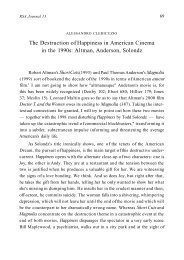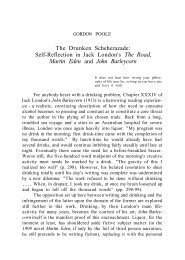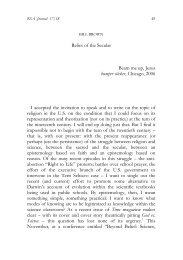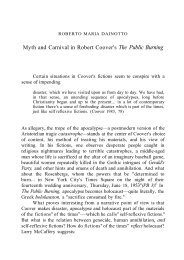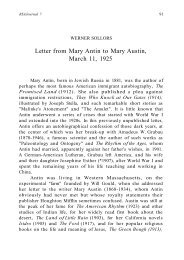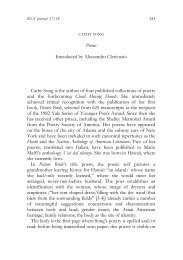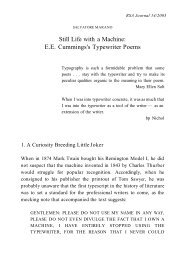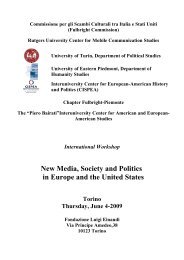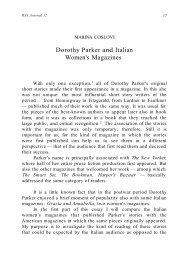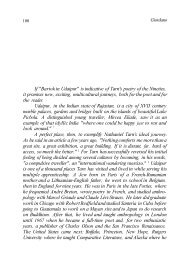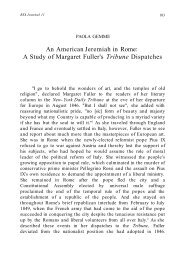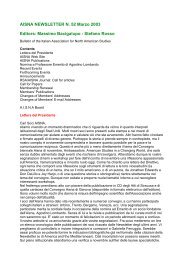Horizontal and Vertical Themes in Joan Didion's Memoir ... - aisna
Horizontal and Vertical Themes in Joan Didion's Memoir ... - aisna
Horizontal and Vertical Themes in Joan Didion's Memoir ... - aisna
- No tags were found...
You also want an ePaper? Increase the reach of your titles
YUMPU automatically turns print PDFs into web optimized ePapers that Google loves.
RSA 15-16 (2004-2005)CRISTINA SCATAMACCHIA<strong>Horizontal</strong> <strong>and</strong> <strong>Vertical</strong> <strong>Themes</strong> <strong>in</strong><strong>Joan</strong> <strong>Didion's</strong> <strong>Memoir</strong> Where I Was From1. Accord<strong>in</strong>g to Kather<strong>in</strong>e Usher Henderson, "Few American writers are'American' <strong>in</strong> all the ways that <strong>Joan</strong> Didion is" (140). Didion, a celebratedjournalist <strong>and</strong> fiction writer, has published five novels <strong>and</strong> several collectionsof essays, from Slouch<strong>in</strong>g Towards Bethlehem (1968) <strong>and</strong> The WhiteAlbum (1979), highly <strong>in</strong>fluential <strong>and</strong> groundbreak<strong>in</strong>g examples of newjournalism <strong>in</strong>vestigat<strong>in</strong>g themes like social fragmentation <strong>and</strong> rootlessness,to the more recent PoliticalFictions (2001) on the work<strong>in</strong>gs of Americanelectoral politics, <strong>and</strong> Fixed Ideas: America S<strong>in</strong>ce 9.11 (2003), a dissectionof the Bush adm<strong>in</strong>istration's tactics <strong>and</strong> strategies for determ<strong>in</strong><strong>in</strong>gthe public perception of the terrorist attacks <strong>and</strong> the war <strong>in</strong> Iraq thatfollowed. While writ<strong>in</strong>g on so many different subjects, she has alwaysanalyzed <strong>and</strong> <strong>in</strong>terpreted them from a highly personal viewpo<strong>in</strong>t <strong>and</strong> aspecific Western ideological perspective. Didion, <strong>in</strong> fact, was born <strong>in</strong>Sacramento <strong>in</strong> 1934 <strong>in</strong>to an upper-middle class family <strong>and</strong> her workreflects her experience as an American <strong>and</strong> a Californian. Her identity asa daughter of California has caused many of her essays to be both regional<strong>and</strong> autobiographical <strong>in</strong> focus (W<strong>in</strong>chell 94; Muggli 402; Roiphe 1-2).The mythology of her native state figures prom<strong>in</strong>ently <strong>in</strong> them, as sheseeks to render the moral complexity of the American Western experience,its dilemmas <strong>and</strong> ambiguities. Even when she deals with largersocial <strong>and</strong> economic forces at work <strong>in</strong> contemporary American politics,she underst<strong>and</strong>s them <strong>in</strong> terms of her own peculiarly Californian sensibility(Davidson 36; Didion, "Th<strong>in</strong>k<strong>in</strong>g" 10).I <strong>in</strong>tend to consider <strong>Didion's</strong> 2003 book, Where I Was From, as wellas a number of autobiographical essays <strong>and</strong> <strong>in</strong>terviews. This book is acomplex <strong>and</strong> challeng<strong>in</strong>g text, partly a memoir of her family's pioneer
70 Crist<strong>in</strong>a Scatamacchiapast <strong>and</strong> partly a reassessment of the history of California. It is a k<strong>in</strong>d ofbookend to her earlier mus<strong>in</strong>gs on her native state <strong>and</strong> it <strong>in</strong>vestigates horizontalthemes (the pioneers' cross<strong>in</strong>g of the American cont<strong>in</strong>ent as wellas the author's personal cross<strong>in</strong>gs, that is, her recurrent moves back <strong>and</strong>forth between California <strong>and</strong> New York) <strong>and</strong> vertical themes (the role ofthe federal government as the ma<strong>in</strong> cause for social <strong>and</strong> political change<strong>in</strong> California from the Gold Rush to the present). Such horizontal <strong>and</strong>vertical themes, <strong>in</strong>tersect<strong>in</strong>g both <strong>Didion's</strong> life <strong>and</strong> her books, emergehere through the description of her ambivalent, often pa<strong>in</strong>ful, relationshipwith a set of specific Western ideas that over the years she has cometo reject, <strong>and</strong> through an endear<strong>in</strong>g recollection of her family past,<strong>in</strong>clud<strong>in</strong>g her women ancestors. She is thus able to create an enquiry <strong>in</strong>tothe spirit of a unique place <strong>and</strong>, at the same time, the soul of her uncommonfamily. Accord<strong>in</strong>g to Nicholas Howe, the value of personal bookslike Where I Was From is <strong>in</strong> illum<strong>in</strong>at<strong>in</strong>g how myths or core beliefs or storiesmatter to the politics <strong>and</strong> history of those places (86).Didion mixes political analysis, family history <strong>and</strong> journalisticreports to expose as false <strong>and</strong> self-delud<strong>in</strong>g three susta<strong>in</strong><strong>in</strong>g myths thatconstitute the essence of the California dream. Throughout much ofAmerican history the image of California has had a mythic identity: asthe geographic limit of the westward movement, it created higher expectationsthan other states <strong>and</strong> came to represent a earthly paradise, a gardenof Eden, a far-off golden l<strong>and</strong> of promise. Yet, s<strong>in</strong>ce the beg<strong>in</strong>n<strong>in</strong>gthere was a gap between the reality of California <strong>and</strong> the popular imageby which the state def<strong>in</strong>ed itself. There was a dissonance between theway Californians perceived themselves <strong>and</strong> the way they were, "betweenwhat they believed to be their unlimited possibilities <strong>and</strong> the limitationsimplicit <strong>in</strong> their own character <strong>and</strong> history" (48). Didion, therefore, hasattempted to illum<strong>in</strong>ate the dark side of these pioneer myths, the veryheart of the American mystique. They constitute a set of values peculiarto Californians, but also American to the core. She is deeply concernedabout such values, even though she sees them only as myths <strong>and</strong> illusions.
<strong>Horizontal</strong> <strong>and</strong> <strong>Vertical</strong> <strong>in</strong> <strong>Joan</strong> Didion71As a result, the Western experience, by its very nature, appears quite paradoxicalto her. The three susta<strong>in</strong><strong>in</strong>g <strong>and</strong> <strong>in</strong>terconnected myths of theCalifornia dream that she exposes <strong>in</strong> her book are: (a) The redemptivepower of the pioneers' cross<strong>in</strong>g of the cont<strong>in</strong>ent; (b) Western <strong>in</strong>dividualism<strong>and</strong> distrust of the federal government; <strong>and</strong> (c) The postwar years'social changes as a betrayal of the orig<strong>in</strong>al values of the state.2. Didion has always been fasc<strong>in</strong>ated by the history of westward migration<strong>in</strong> America toward California, because she belongs to a family whosemembers have lived on the frontier s<strong>in</strong>ce before the revolution: there havebeen "twelve generations of circuit riders <strong>and</strong> county sheriffs <strong>and</strong> Indianfighters <strong>and</strong> country lawyers <strong>and</strong> Bible readers" (219-20). In the essay"Notes from a Native Daughter" she had already mentioned her ancestorswho for two hundred years had been mov<strong>in</strong>g west on the frontier <strong>and</strong>had been clear<strong>in</strong>g Virg<strong>in</strong>ia, Kentucky, Missouri <strong>and</strong> Tennessee (173). Inthe mid-n<strong>in</strong>eteenth century her cont<strong>in</strong>ent-cross<strong>in</strong>g ancestors came to California<strong>and</strong> settled <strong>in</strong> Sacramento: the first members of her family arrived<strong>in</strong> 1846, while other branches of the same family followed <strong>in</strong> the year1852. She grew up <strong>in</strong> that town, where local history <strong>and</strong> patriotism were<strong>in</strong>tense, <strong>and</strong> the found<strong>in</strong>g of California was perceived as a romantic <strong>and</strong>heroic deed (Moses 2). As she wrote <strong>in</strong> 1948 <strong>in</strong> a speech to be deliveredat her eighth-grade graduation, the pioneers who came to California were"different" from those who settled <strong>in</strong> other Western states. They camewest for "adventure <strong>and</strong> money." In Where I Was From it is precisely thislegacy of the American frontier, <strong>in</strong>herited by Didion as a child, that shehas set out to criticize outl<strong>in</strong><strong>in</strong>g the confusion embedded <strong>in</strong> the cross<strong>in</strong>gstory (75).She disagrees, <strong>in</strong> particular, with the ideas of Josiah Royce who"<strong>in</strong>vented" the myth of the redemptive power of the cross<strong>in</strong>g of theAmerican cont<strong>in</strong>ent, to these days one of the fixed ideas of the Californiasettlement. Royce grew up <strong>in</strong> San Francisco, but he later moved to theEast Coast becom<strong>in</strong>g from 1885 to 1916 a central figure of the Harvard
72 Crist<strong>in</strong>a Scatamacchiaphilosophy department. In 1886 he published California: A Study ofAmerican Character <strong>in</strong> which he held that the cross<strong>in</strong>g had an aspect ofquest: it was a pilgrimage, a redeem<strong>in</strong>g journey. "In a sense," Didion hasnoticed, "each traveler died at the moment of leav<strong>in</strong>g, but was reborn <strong>in</strong>the wilderness dur<strong>in</strong>g the cross<strong>in</strong>g, arriv<strong>in</strong>g <strong>in</strong> California as a new creature."And <strong>in</strong> a radio <strong>in</strong>terview she has added that "not only you startedover aga<strong>in</strong>, you started over clean. The cross<strong>in</strong>g had redeemed you"(Interview).In real life the cross<strong>in</strong>g was far removed from the noble odysseychronicled by California mythmakers. Rather than a noble odyssey, it was"a mean scrambl<strong>in</strong>g for survival," s<strong>in</strong>ce the pioneers arrived <strong>in</strong> California<strong>in</strong> wrecked wagons, hav<strong>in</strong>g faced desolation <strong>and</strong> death. It was an arduousjourney, full of accidents <strong>and</strong> betrayals. It was, above all, a one-way journey:no return home was allowed. As primary sources <strong>in</strong> support of herthesis, Didion has referred to the diaries of several early pioneers whomade the journey across the cont<strong>in</strong>ent <strong>in</strong> mid-n<strong>in</strong>eteenth century. Fromthe journal of her own great-great gr<strong>and</strong>father, William Kilgore, she hasquoted a passage about the bitterness of part<strong>in</strong>g, of ab<strong>and</strong>on<strong>in</strong>g foreverhome <strong>and</strong> relatives: "This is one of the try<strong>in</strong>g morn<strong>in</strong>gs for me, as I nowhave to leave my family, or back out. Suffice to say, we started" (20). Thejournal of Josiah Royce's mother, Sarah, who made the cross<strong>in</strong>g to Sacramento<strong>in</strong> 1849 with her husb<strong>and</strong> <strong>and</strong> first child, conta<strong>in</strong>s a similar sadremark: "I had for months anticipated this hour yet, not till it came, didI realize the blank drear<strong>in</strong>ess of see<strong>in</strong>g night come on without house orhome to shelter us <strong>and</strong> our baby girl" (29).In order to survive the dangers of the wilderness, one was notallowed to stop or to look back. Even sentiments like grief <strong>and</strong> dissent,cost time. The diaries of early pioneers refer to the Sierra Nevada as "themost dreaded moment," because its passage was the meet terrify<strong>in</strong>g of alltrials they had to overcome. Didion has found out that "IndependenceRock, west of Fort Laramie on the Sweetwater River, was so namedbecause the traveler who had not reached that po<strong>in</strong>t by the Fourth ofJuly,
<strong>Horizontal</strong> <strong>and</strong> <strong>Vertical</strong> <strong>in</strong><strong>Joan</strong> Didion73Independence Day, would not reach the Sierra Nevada before snow closedthe passes" (32-33). With regard to this, <strong>in</strong> the journal of another earlypioneer Didion has discovered the story of the f<strong>in</strong>d<strong>in</strong>g by a party mov<strong>in</strong>gwest of a str<strong>and</strong>ed seventeen year old girl, Miss Gilmore, <strong>and</strong> herdy<strong>in</strong>g little brother. Their parents had already died of the same disease<strong>and</strong> their wagon was blocked because the oxen were lost. The people ofthe wagon tra<strong>in</strong> they had been travell<strong>in</strong>g with had ab<strong>and</strong>oned them, fearfulof be<strong>in</strong>g caught by w<strong>in</strong>ter <strong>in</strong> the passes of the Sierra Nevada, if theydelayed any longer (36).Miss Gilmore's story impressed Didion very deeply, because itappeared to her as a symbol of the moral ambiguity of the Californian settlement.When, later on, she was asked <strong>in</strong> an <strong>in</strong>terview if she believedthat the story of com<strong>in</strong>g across the pla<strong>in</strong>s to California always entailed theab<strong>and</strong>onment of others, she answered: "I th<strong>in</strong>k it does. That was the heartof the cross<strong>in</strong>g story: leav<strong>in</strong>g people beh<strong>in</strong>d." She also observed that twoth<strong>in</strong>gs have struck her about it: "One was ab<strong>and</strong>onment, <strong>and</strong> the other isthe fact that ... it's an enterprise the whole po<strong>in</strong>t of which is survival"(O'Hehir 9). Inevitably, then, she was forced to raise the follow<strong>in</strong>g excruciat<strong>in</strong>gquestion: "When you survive at the cost of Miss Gilmore <strong>and</strong>her brother, do you survive at all?" (37).To early pioneers surviv<strong>in</strong>g often meant resort<strong>in</strong>g to extreme solutions<strong>in</strong> the face of a hostile <strong>and</strong> terrify<strong>in</strong>g natural world. Those whoab<strong>and</strong>oned Miss Gilmore <strong>and</strong> her brother were anxious, by mov<strong>in</strong>g on,to avoid the ill-fated experience of the Donner-Reed Party of eighty-sevenpioneers travell<strong>in</strong>g from Ill<strong>in</strong>ois to California <strong>in</strong> 1846. They were forcedby w<strong>in</strong>ter storms to make camp <strong>in</strong> the Sierras, <strong>and</strong> forty of them survived<strong>in</strong> these mounta<strong>in</strong>s by eat<strong>in</strong>g their own dead. <strong>Didion's</strong> great-great-greatgr<strong>and</strong>mother, Nancy Hard<strong>in</strong> Cornwall, was a member of the orig<strong>in</strong>alparty, even though she <strong>and</strong> her husb<strong>and</strong> left the group <strong>in</strong> Nevada, atHumboldt S<strong>in</strong>k, to take the northern route through Oregon to California.Didion admits even today to be<strong>in</strong>g "haunted by the cannibalism" ofthe Donner-Reed Party, <strong>and</strong> <strong>in</strong> her study she has a framed photograph of
74 Crist<strong>in</strong>a Scatamacchiathe Sierra Nevada as a rem<strong>in</strong>der of those early pioneers. Actually, thestory of the Donner-Reed experience seems to come up <strong>in</strong> her books(<strong>in</strong>clud<strong>in</strong>g Where I Was From) every few pages because it is for her anemblem of the realistic, as opposed to the romantic, version of the westwardmigration <strong>in</strong> the United States (Kaz<strong>in</strong> 112; Kakutani, "<strong>Joan</strong> Didion"38).Virg<strong>in</strong>ia Reed, one of the surviv<strong>in</strong>g children of the Donner-ReedParty, wrote to her cous<strong>in</strong>: "Thank God, we are the only family that didnot eat human flesh. We have left everyth<strong>in</strong>g, but I don't care for that.We have got through with our lives. Don't let this letter dishearten anybody.Remember, never take no cutoffs <strong>and</strong> hurry along as fast as you can"(75). Not every settler paid such a high price for survival, but everyonedid pay a price for com<strong>in</strong>g. Thus, reject<strong>in</strong>g the view of California's firstsettlers as romantic pioneers, Didion stresses the risk <strong>and</strong> hardship thateach of them <strong>in</strong>evitably bore dur<strong>in</strong>g the bitterly hard journey. No wonderthat after the trials of the wilderness California appeared to them asthe Eldorado, a l<strong>and</strong> promis<strong>in</strong>g freedom <strong>and</strong> opportunity! She also <strong>in</strong>vestigatesthe pioneers' personal reasons for com<strong>in</strong>g west, h<strong>in</strong>t<strong>in</strong>g that perhapstheir deepest drive was neither for wealth nor for material ga<strong>in</strong>.They misunderstood their own motives <strong>and</strong> talked about want<strong>in</strong>g gold<strong>and</strong> l<strong>and</strong> <strong>in</strong> California, but <strong>in</strong> fact they were <strong>in</strong> search of a renewed identity.As Mark Royden Wichell has po<strong>in</strong>ted out, Didion believes thatAmericans went west primarily "to run away" from their homes as wellas from themselves, <strong>and</strong> they kept push<strong>in</strong>g west <strong>in</strong> search of a new senseof self. The cross<strong>in</strong>g, thus, was a way of escap<strong>in</strong>g "that dread of the mean<strong>in</strong>glessnesswhich was man's fate" (7).3. Emphasis on rugged <strong>in</strong>dividualism <strong>and</strong> distrust of centralized governmentalauthority constitute the local core belief <strong>in</strong> California. However,accord<strong>in</strong>g to Didion, this k<strong>in</strong>d of unfettered <strong>in</strong>dividualism is highlyambiguous, s<strong>in</strong>ce the federal government, which many Californian citizensprofess to hate, has always funded their state. The dependence on the
<strong>Horizontal</strong> <strong>and</strong> <strong>Vertical</strong> <strong>in</strong> <strong>Joan</strong> Didion75federal government, which seem<strong>in</strong>gly runs counter to the preferred selfimageof most Californians, represents a pattern already set <strong>in</strong> the firstdecade after California was admitted to the union as a state <strong>in</strong> 1850. Suchextreme reliance upon federal money has led Didion to <strong>in</strong>fer that the stateitself was basically created by the federal government (Eggers 3).A turn<strong>in</strong>g po<strong>in</strong>t <strong>in</strong> the history of California was the build<strong>in</strong>g of theSouthern Pacific Railroad, that provided an easy way across the SierraNevada <strong>and</strong>, together with the l<strong>in</strong>k to the Central Pacific Railroad, saw theformation of the Transcont<strong>in</strong>ental Railroad <strong>in</strong> 1869. California, thus, wasl<strong>in</strong>ked to the East <strong>and</strong> opened to extensive settlement. Although a quartetof Sacramento shopkeepers built the Southern Pacific Railroad — CharlesCrocker, Lel<strong>and</strong> Stanford, Collis Hunt<strong>in</strong>gton <strong>and</strong> Mark Hopk<strong>in</strong>s — it wasthe federal money that f<strong>in</strong>anced it. The citizens of the rest of the countrywere the ones who actually paid for the build<strong>in</strong>g of that railroad, througha federal cash subsidy plus a federal l<strong>and</strong> grant. In this way, the SouthernPacific became through its federal l<strong>and</strong> grants the largest Californial<strong>and</strong>owner of the n<strong>in</strong>eteenth century (<strong>and</strong> even as late as the 1960s stillowned roughly two <strong>and</strong> a half million acres) (24-25,60,79-80).Although contradictory, these events do not seem unusual to Didion,s<strong>in</strong>ce she holds that from the time of the Gold Rush a speculative spirithas always prevailed among Californians as a negative side of their character.From the very beg<strong>in</strong>n<strong>in</strong>g of the history of the state most of its citizenshave shared the notion of cutt<strong>in</strong>g loose <strong>and</strong> strik<strong>in</strong>g it rich, underst<strong>and</strong><strong>in</strong>gquite clearly that the richest claim of all lay not <strong>in</strong> the goldenm<strong>in</strong>efields but <strong>in</strong> Wash<strong>in</strong>gton. The residents of California have alwaysbeen will<strong>in</strong>g to mortgage the future for a short-term payout: "One oftrad<strong>in</strong>g the state to outside owners <strong>in</strong> exchange for their (it now seems)entirely temporary agreement to enrich us, <strong>in</strong> other words the pauperizationof California" (89). As a result, there has never been a real yeomantradition: the myth of the solitary yeoman diligently tend<strong>in</strong>g his 160acres was confounded by the spectacle of gigantic l<strong>and</strong>hold<strong>in</strong>gs number<strong>in</strong>ghundreds of thous<strong>and</strong>s of acres. California itself "by the year Royce
76 Crist<strong>in</strong>a Scatamacchiawrote, 1886, had already sold half the state to the Southern Pacific <strong>and</strong>was <strong>in</strong> the process of mortgag<strong>in</strong>g the rest to the federal government"(90).Didion then quotes Henry George: "What is the railroad to do forus? — this railroad that we have looked for, hoped for, prayed for so long?"as an appropriate illustration of Frank Norris's 1901 novel, The Octopus:A Story ofCalifornia. Norris was a crusad<strong>in</strong>g novelist <strong>and</strong> his work of fiction,based on recent history <strong>in</strong> the San Joaqu<strong>in</strong> Valley, portrays the clashbetween federal marshals act<strong>in</strong>g for the Southern Pacific <strong>and</strong> a group oflocal ranchers. Yet the plot of the novel presents several ambiguitiesallow<strong>in</strong>g Didion to <strong>in</strong>terpret it <strong>in</strong> a new <strong>and</strong> orig<strong>in</strong>al way. She contendsthat The Octopus "is not, as it might logically seem to be, a story of anagrarian society overtaken by the brutal momentum of <strong>in</strong>dustrialization,"because the ranchers share the same speculative spirit that undergirds theactions of the Southern Pacific Railroad. The octopus itself, accord<strong>in</strong>g toher, is not even the railroad but <strong>in</strong>different nature. Thanks to the enigmaticalelements that compound the plot, Didion is ready to praise thenovel very highly: "The Octopus rema<strong>in</strong>s perhaps the most complex statementto date of the Californian condition, <strong>and</strong> a deeply ambiguous work"(44-45).The <strong>in</strong>tervention of the federal government <strong>in</strong> California, however,has gone far beyond the fund<strong>in</strong>g of the railroads. Over the years it hascreated the California State Water Project, a gigantic system of watercontrol that — through dams, canals <strong>and</strong> levees — has brought fertility tomillions of acres of l<strong>and</strong>. A pattern of flood<strong>in</strong>g characterized the SacramentoRiver before its flow was controlled <strong>and</strong> rearranged, so that <strong>in</strong> the1860s <strong>and</strong> 1870s a large part of the l<strong>and</strong> ly<strong>in</strong>g between Sacramento, SanFrancisco, <strong>and</strong> Stockton was marked as swamp <strong>and</strong> overflowed l<strong>and</strong>.Instead, <strong>in</strong> the same years the San Joaqu<strong>in</strong> Valley was arid <strong>and</strong> desolatewhile today, hav<strong>in</strong>g been irrigated, it has become a fruitful garden. ButDidion is eager to po<strong>in</strong>t out that if the Sacramento River represents nowthe ma<strong>in</strong> source of surface water, the stagger<strong>in</strong>g cost of controll<strong>in</strong>g or
<strong>Horizontal</strong> <strong>and</strong> <strong>Vertical</strong> <strong>in</strong> <strong>Joan</strong> Didion77rearrang<strong>in</strong>g its flow, "which is to say the 'reclamation' of the SacramentoValley, was largely borne, like the cost of controll<strong>in</strong>g or rearrang<strong>in</strong>g manyother <strong>in</strong>convenient features of Californian life, by the federal government"(21-23).In other words, American taxpayers once aga<strong>in</strong> paid for its cost, <strong>and</strong>they are actually cont<strong>in</strong>u<strong>in</strong>g to pay for it, because the creation of theentirely artificial environment that is now the Sacramento Valley has generated,paradoxically, a further <strong>in</strong>put of federal money <strong>in</strong> the state. In fact,while the California State Water Project makes available the waterrequired to cultivate the crop at a nom<strong>in</strong>al subsidized price, an agency ofthe federal government named the Central Valley Project subsidizes thecrop itself through the commodity-support program of the Departmentof Agriculture. In this way, federal money has formed the agribus<strong>in</strong>ess, "avast agricultural mechanism <strong>in</strong> a k<strong>in</strong>d of market vacuum" for the benefitof several hundred growers, most of them corporate, that are granted bothirrigation water at subsidized price <strong>and</strong> irrigation subsidies (25-26). In1987 such subsidies amounted to twenty-seven million dollars, elevenmillion of which went to the Southern Pacific L<strong>and</strong> Company. As a commentto this absurd situation, Didion has employed a phrase that wascommon <strong>in</strong> her youth: "You can't buck the railroad" (51).4. After World War II the old California of rich growers <strong>and</strong> ranchers wasreplaced by the new California of rapid hous<strong>in</strong>g development <strong>and</strong> defense<strong>in</strong>dustries. Sweep<strong>in</strong>g changes rapidly transformed the state, <strong>and</strong> onceaga<strong>in</strong> such changes found their <strong>in</strong>put <strong>in</strong> the federal government. Fromthe postwar years to the early 1990s, <strong>in</strong> fact, the federal governmentthrough the agency of its defense <strong>and</strong> aerospace <strong>in</strong>dustries created <strong>and</strong>susta<strong>in</strong>ed a new type of economy based on the threat of nuclear war. Thisgave rise to California's postwar economic boom: corporations likeNorthrop, Aerojet General <strong>and</strong> McDonnell Douglas attracted millions ofworkers from other states, while plans for <strong>in</strong>tensive real estate developmentto house the newcomers required the sell<strong>in</strong>g of the great ranches.
78 Crist<strong>in</strong>a ScatamacchiaThus, <strong>in</strong> spite of the <strong>in</strong>dividualism of the state's residents, California cont<strong>in</strong>uedto be largely <strong>and</strong> <strong>in</strong>creas<strong>in</strong>gly subsidized by the federal government."These are the k<strong>in</strong>ds of contradictions" accord<strong>in</strong>g to Didion "onwhich Californians have tended to founder when they try to th<strong>in</strong>k aboutthe place they come from." In the good years there was a perfect synergy<strong>in</strong> the big aerospace <strong>and</strong> defense <strong>in</strong>dustries— politicians, contracts, voters— but around 1992 the boom ended after four decades of good will on thepart of the federal government. As government spend<strong>in</strong>g was slashed,aerospace <strong>and</strong> defense plants started clos<strong>in</strong>g down or relocat<strong>in</strong>g outsidethe state, <strong>and</strong> this began to unsettle California s<strong>in</strong>ce virtually every countydepended on defense contracts for billions <strong>and</strong> billions of federal dollars.While hundreds of thous<strong>and</strong> of jobs were lost, California fell victimof her own myths (Beasley 17; Porterfield 74).In the light of the events that dur<strong>in</strong>g the last fifty years have determ<strong>in</strong>edsuch swift <strong>and</strong> pervasive changes <strong>in</strong> California, eventually culm<strong>in</strong>at<strong>in</strong>g<strong>in</strong> the present economic crisis, Didion <strong>in</strong>vestigates the mean<strong>in</strong>gof these changes <strong>and</strong> the way they were perceived by the old residents ofher native state. Confronted with the impact of postwar hous<strong>in</strong>g <strong>and</strong><strong>in</strong>dustrial expansion, people like her own family, whose members hadlived there for generations, reacted negatively. In particular, when thegreat ranches were subdivided <strong>and</strong> sold off, they realized that a part ofCalifornia's history was erased. Perceiv<strong>in</strong>g such change as social <strong>and</strong> culturaldecl<strong>in</strong>e, they compla<strong>in</strong>ed that the state had changed, regretted thepast <strong>and</strong> shunned newcomers: "New people could be seen, by people likemy gr<strong>and</strong>father, as <strong>in</strong>different to everyth<strong>in</strong>g that had made Californiawork, but the ambiguity was this: new people were also those who weremak<strong>in</strong>g California rich" (96).Didion is quite aware that the same k<strong>in</strong>d of attitude still shaped heras a writer early <strong>in</strong> her career. Nostalgia for the old Sacramento of heryouth emerged <strong>in</strong> her 1963 novel, Run River, <strong>and</strong> became a recurrenttheme <strong>in</strong> her subsequent work. As Michiko Kakutani has po<strong>in</strong>ted out, <strong>in</strong>her first two collections of essays, Slouch<strong>in</strong>g Towards Bethlehem <strong>and</strong> The
<strong>Horizontal</strong> <strong>and</strong> <strong>Vertical</strong> <strong>in</strong> <strong>Joan</strong> Didion79White Album, "aga<strong>in</strong> <strong>and</strong> aga<strong>in</strong> she drew contrasts between the old Californiashe knew from childhood <strong>and</strong> family stories ... <strong>and</strong> the new Californiaof aerospace plants <strong>and</strong> subdivisions <strong>and</strong> fast-food restaurants, aplace where rootlessness <strong>and</strong> anomie of the sixties seemed to have takenpermanent hold" (Kakutani, "Golden State" 1). By juxtapos<strong>in</strong>g a visionof the past with one of the present, Didion conveyed a sense of loss for aworld that had ceased to exist. However, if <strong>in</strong> the essay "Notes from aNative Daughter" she appeared nostalgic, she did not overlook the shortcom<strong>in</strong>gsof the pre-Sunbelt West <strong>and</strong> avoided idealization: "Did not theDonner-Reed Party, after all, eat its own dead to reach Sacramento?"(176). At the end of the same essay she wondered whether she was actuallymourn<strong>in</strong>g the old Sacramento or her own childhood: "This has beena story not about Sacramento at all, but about the th<strong>in</strong>gs we lose <strong>and</strong> thepromises we break as we grow older" (186).Over the years <strong>Didion's</strong> vision of the past has gradually evolved: areassessment <strong>and</strong> reappraisal of her th<strong>in</strong>k<strong>in</strong>g about her home state have<strong>in</strong>duced her to ab<strong>and</strong>on the dichotomies of her earlier work. "Onlyrecently did I come ... to underst<strong>and</strong> 'change' itselfas one ofthe culture'smost endur<strong>in</strong>g misunderst<strong>and</strong><strong>in</strong>gs about itself' (187-88). She has realizedthat what looks like modern deterioration from an idealized past, isreally the expression of qualities that have underla<strong>in</strong> the state's history.Consequently, she argues now that boom <strong>and</strong> change are the fundamentalqualities of the California experience from the time of the Gold Rushto the present. For example, the gigantic population growth that hasoccurred after World War II has been <strong>in</strong> no way unprecedented. In thecourse of her life, from the mid-1930s to the present, the population ofCalifornia has <strong>in</strong>creased from six million to close to thirty-six millionpeople, almost fifteen percent of the United States total population. Yetthis growth was part of a longer trend, s<strong>in</strong>ce each decade from 1860 to1960 registered an average <strong>in</strong>crease of fifty percent: no other part of theUnited States was ever so rapidly peopled. Accord<strong>in</strong>g to Didion, "therehad been ... from the beg<strong>in</strong>n<strong>in</strong>g, these obliterat<strong>in</strong>g <strong>in</strong>creases, rates of
80 Crist<strong>in</strong>a Scatamacchiagrowth that systematically erased freshly laid traces of custom <strong>and</strong> community,<strong>and</strong> it was from such erasures that many California confusionswould derive" (173). In this perspective the question of "changes" <strong>in</strong>volv<strong>in</strong>ga paradise lost - that is, the transformation of the state from what ithad been (or from what its citizens preferred to believe it had been) towhat it is now — becomes a vexed issue: "Discussion of how California has'changed,' then, tends locally to def<strong>in</strong>e the more ideal California as thatwhich existed at whatever past po<strong>in</strong>t the speaker first saw it" (87, 170).Didion holds that boom <strong>and</strong> change represent the most evident <strong>and</strong>pervasive elements <strong>in</strong> the history of her native state, so that, <strong>in</strong> a way, Californiahas not changed at all. However, <strong>in</strong> the last decades there has beena tremendous difference <strong>in</strong> the environment, s<strong>in</strong>ce a large part of thewilderness has been destroyed to build suburban houses <strong>and</strong> shopp<strong>in</strong>gmalls. Didion offers a personal anecdote <strong>and</strong> turns it <strong>in</strong>to a culturalmetaphor of how "all that is constant <strong>in</strong> the California of my childhoodis the rate at which it disappears." In 1992, a few months after her fatherdied, she drove her mother from Monterey to Berkeley where they wereto spend a few nights at the Claremont Hotel because Didion was tospeak at the University of California. Dur<strong>in</strong>g the trip her mother keptask<strong>in</strong>g whether they were on the right road. When she was reassured thatthey were travell<strong>in</strong>g on the 101 North, she asked: "Then where did it allgo?" In the two or three years dur<strong>in</strong>g which she had been car<strong>in</strong>g for herhusb<strong>and</strong> the countryside had changed, <strong>and</strong> the lawns where the cattleused to graze had been replaced by "mile after mile of pastel subdivisions<strong>and</strong> labyr<strong>in</strong>th<strong>in</strong>e exits <strong>and</strong> entrances to freeways that had not previouslyexisted. For miles she was silent. California had become, she said then,'all San Jose'" (215-16).After the publication of her memoir, Didion was asked to commentupon the fact that California's countryside has been partly destroyed by<strong>in</strong>tensive real estate development: "That's certa<strong>in</strong>ly true. That's what mymother meant when she said, 'Where did it all go? It's all San Jose.' Butthen the whole idea of 'California as it was' — it br<strong>in</strong>gs you to that ques
<strong>Horizontal</strong> <strong>and</strong> <strong>Vertical</strong> <strong>in</strong><strong>Joan</strong> Didion81tion, which you can't avoid: If we could see it 'as it was,' how many of uscould afford to see it? What California is, for better or worse, is someth<strong>in</strong>gthat has come to support huge numbers ofpeople <strong>and</strong> their variousdreams for the future" (Kakutani, "Golden" 8). Accord<strong>in</strong>g to AndrewO'Hehir, this was "an effort to reconcile <strong>Didion's</strong> passionate feel<strong>in</strong>gs forthe state, <strong>and</strong> her sense of loss about see<strong>in</strong>g its magnificent l<strong>and</strong>scapedevoured, without surrender<strong>in</strong>g to elitist sentimentality" (3).5. Before writ<strong>in</strong>g Where I Was From, Didion published a number of autobiographicalessays <strong>in</strong> which she dealt with the mean<strong>in</strong>g of the old Sacramentoof her youth, but she showed a considerable reticence about herparents. Not until her mother died <strong>in</strong> May 2001, two weeks short of hern<strong>in</strong>ety-first birthday, did she set out to write a memoir <strong>in</strong> which sherecalled several episodes of her parents' lives. As a matter of fact, shebegan her book <strong>in</strong> the 1970s, but found it impossible to write <strong>and</strong> put itaside. It was not only her feel<strong>in</strong>gs toward her family that prevented herfrom complet<strong>in</strong>g her work, but also the fact that the whole subject wascreat<strong>in</strong>g <strong>in</strong> her m<strong>in</strong>d too many questions that she was unable to answer:California was a weary<strong>in</strong>g enigma to Didion. In the follow<strong>in</strong>g years shewrote three long pieces for the New Yorker <strong>and</strong> one for the New YorkReview of Books, hop<strong>in</strong>g they would help her to clarify her views, but shefound the impetus to complete her memoir only after the death of hermother, as she subsequently confessed: "I had thought of do<strong>in</strong>g it, but itbecame an overwhelm<strong>in</strong>g sense of someth<strong>in</strong>g to do after she died"(Hirschhorn 68). She went back to write it although she still did not havea clear notion of her subject, as she admitted <strong>in</strong> an <strong>in</strong>terview about theprogress of her work: "I'm about half way <strong>in</strong>, two-thirds of the waythrough. It's nonfiction. I'm sort of stymied by it right now. I don't knowexactly where I'll go from where I am ... It goes k<strong>in</strong>d of to someplaceelse" (Wimmer 42). This statement confirmed <strong>Didion's</strong> earlier def<strong>in</strong>itionof writ<strong>in</strong>g as an act of self-discovery, which she had first expressed <strong>in</strong> herfamous 1976 essay "Why I Write": "I write entirely to f<strong>in</strong>d out what I'm
82 Crist<strong>in</strong>a Scatamacchiath<strong>in</strong>k<strong>in</strong>g, what I'm look<strong>in</strong>g at, what I see <strong>and</strong> what it means. What Iwant <strong>and</strong> what I fear" (2).In the case of Where I Was From, however, many questions stillrema<strong>in</strong> unsolved: "This book represents an exploration <strong>in</strong>to my own confusionsabout the place <strong>and</strong> the way <strong>in</strong> which I grew up, confusions asmuch about America as about California, misapprehensions <strong>and</strong> misunderst<strong>and</strong><strong>in</strong>gsthat are so much a part of who I became that to this day Istill confront them only obliquely" (34). Later she has made it clear thatthis is a book about America <strong>in</strong> so far as the idea of mov<strong>in</strong>g west hasalways been the key to her idea of America. Where I Was From, therefore,is about her fall<strong>in</strong>g away from the very idea of California she <strong>in</strong>herited,the whole story be<strong>in</strong>g essentially Manifest Dest<strong>in</strong>y. S<strong>in</strong>ce it is not somuch about her home state as it is about her state of m<strong>in</strong>d, the pervasivetone of <strong>Didion's</strong> meditation is elegiac, due also to the sadness of becom<strong>in</strong>gan orphan after her mother's death. The tone of her prose, however,is also one of irony (O'Hehir 3).Didion makes her verdicts personal by present<strong>in</strong>g her own family—Californians for five generations — as prime embodiments of the state'scontradictions. Thus, autobiography is made to serve a larger po<strong>in</strong>t (Aviv2). Although she sees many discrepancies <strong>in</strong> the attitudes <strong>and</strong> the mentalityof her parents, a strong bond of affection ties her to the membersher family. In particular, she has always been fasc<strong>in</strong>ated with the extraord<strong>in</strong>arypioneer women who were her ancestors <strong>and</strong> to whom she pays atribute: "These women <strong>in</strong> my family would seem to have been pragmatic<strong>and</strong> <strong>in</strong> their deepest <strong>in</strong>st<strong>in</strong>cts cl<strong>in</strong>ically radical, given to break<strong>in</strong>g cleanwith everyone <strong>and</strong> everyth<strong>in</strong>g they knew" (7). It is noteworthy that <strong>in</strong> her1976 essay "Th<strong>in</strong>k<strong>in</strong>g About Western Th<strong>in</strong>k<strong>in</strong>g" she had employed thesame sentence, remark<strong>in</strong>g that their descendants were a similarly restlesslot (10). The family portraits weave the book together, with charm<strong>in</strong>gaccounts of different, sometimes hilarious, stories about these women.Didion relentlessly translates the events of their lives <strong>in</strong>to parables of theperiod. Such stories now mean to her someth<strong>in</strong>g different from what she
<strong>Horizontal</strong> <strong>and</strong> <strong>Vertical</strong> <strong>in</strong> <strong>Joan</strong> Didion83had been told when she was a girl, because she does not believe anymore<strong>in</strong> the myth of the frontier. Nevertheless, she confesses that they "stillhave power for me ... I don't th<strong>in</strong>k they have any truth for me. I th<strong>in</strong>kthey're stories." And yet "there's no way to shake loose of these stories"because "there is no real way to deal with everyth<strong>in</strong>g we lose" (O'Hehir3-4).This is the key concept around which <strong>Didion's</strong> memoir revolves: thedeath of her parents, the loss of the old Sacramento of her youth, themyths she once believed <strong>in</strong>, the relationship between the past <strong>and</strong> thepresent. She recalls a personal episode that yields a vivid metaphor for hertheme. The last time she saw her mother was eight weeks before she diedof cancer <strong>and</strong>, on that occasion, she gave her a piece of silver flatware, asmall ladle. Her mother said that she had a "special feel<strong>in</strong>g" for it: she hadfound so satisfy<strong>in</strong>g to touch that particular ladle that she had set it aside."Take it," she said, her voice urgent, "I don't want it lost" (225-26). Didionseems to argue that what gets lost <strong>in</strong> the course of one's life can bepartially found aga<strong>in</strong> through remembrance. An object like that smallladle, thus, becomes a tell<strong>in</strong>g symbol of the cont<strong>in</strong>uity between generations.In the 1967 essay "On Go<strong>in</strong>g Home" Didion wrote about return<strong>in</strong>gto her parents' house for the first birthday of her daughter, <strong>and</strong> she madeclear that home for her rema<strong>in</strong>ed the old Sacramento of her youth (164166). She implies the same th<strong>in</strong>g <strong>in</strong> her 2003 memoir, whose title isWhere I Was From rather than Where I Am From, because old Sacramentodoes not exist any more <strong>and</strong> she has not really found a new home. Thispartly expla<strong>in</strong>s why she has moved every few years from one place toanother, show<strong>in</strong>g a restlessness quite similar to that of her women ancestors.After graduat<strong>in</strong>g from the University of California at Berkeley <strong>in</strong>1956, she went to New York <strong>and</strong> lived there for eight years ("Goodbye"225-38). Then she moved back to the West Coast along with her husb<strong>and</strong>,but rather than return<strong>in</strong>g to Sacramento, she went to live <strong>in</strong> LosAngeles <strong>and</strong> still felt restless. In the essay "On the Morn<strong>in</strong>g After the
86 Crist<strong>in</strong>a Scatamacchiaof concrete events <strong>and</strong> personal experiences, focus<strong>in</strong>g on reveal<strong>in</strong>g details.The themes she <strong>in</strong>vestigates are either vertical or horizontal, even thoughthey may acquire both features accord<strong>in</strong>g to their chang<strong>in</strong>g relationshipwith the public <strong>and</strong> the private spheres.<strong>Vertical</strong> themes are strictly connected to Western <strong>in</strong>dividualism <strong>and</strong>self-reliance. Accord<strong>in</strong>g to Didion, Californians' stress upon politicaldecentralization <strong>and</strong> distrust ofcentralized federal government contradictthe state's actual reliance on Wash<strong>in</strong>gton. She shows how the role of thefederal government has been the ma<strong>in</strong> cause for social <strong>and</strong> politicalchange <strong>in</strong> California from the creation of the state to the present days. Inparticular, she demonstrates that postwar population <strong>in</strong>crease, socialchange, <strong>and</strong> environmental disruption are all parts of a longer trend thathas been cont<strong>in</strong>uously fostered by Congressional policies. This is a typicallyvertical theme because it implies a hierarchical relationship: California'spolitical <strong>and</strong> economic power structure is — <strong>and</strong> has always been— dependent upon the federal government, that dom<strong>in</strong>ates the state <strong>and</strong>generates most of its economic opportunities. However, when one takes<strong>in</strong>to account the American political system, the relationship between thestate <strong>and</strong> the federal government becomes horizontal, symboliz<strong>in</strong>g thecenter of political power versus the peripheral. At the same time, it is ageographical relationship (thus, once aga<strong>in</strong> a horizontal one) because itrepresents the east of the country as opposed to the west.California's geographical position with<strong>in</strong> the United States leadsDidion to exam<strong>in</strong>e another theme, the pioneers' cross<strong>in</strong>g of the Americancont<strong>in</strong>ent, which is horizontal, be<strong>in</strong>g a westward journey, but it is alsovertical <strong>in</strong> two ways: as a myth of regeneration <strong>and</strong> moral uplift, <strong>and</strong> as asearch for economic opportunities <strong>and</strong> upward social mobility. These twovertical themes are rooted upon the idea of California as a l<strong>and</strong> of promise,which Didion f<strong>in</strong>ds contradictory because the sense of unlimited possibilitiesshared by most <strong>in</strong>habitants of the state contrasts with its actualgeographical <strong>and</strong> social limitations. S<strong>in</strong>ce she believes that California'seconomic opportunities are mostly provided by the federal government,
<strong>Horizontal</strong> <strong>and</strong> <strong>Vertical</strong> <strong>in</strong> <strong>Joan</strong> Didion87rather than be<strong>in</strong>g the result of Western <strong>in</strong>dividualism <strong>and</strong> self-reliance,this opens up the way for her to go back to the first theme of her <strong>in</strong>vestigation,complet<strong>in</strong>g the circularity of her narrative.<strong>Horizontal</strong> <strong>and</strong> vertical themes do not characterize only California'shistory, but they also <strong>in</strong>tersect <strong>Didion's</strong> personal life. Like her womenancestors, she has crossed the American cont<strong>in</strong>ent, mov<strong>in</strong>g recurrentlybetween California <strong>and</strong> New York. When she <strong>and</strong> her husb<strong>and</strong> first leftNew York <strong>in</strong> 1964 <strong>and</strong> settled <strong>in</strong> Los Angeles, they were <strong>in</strong> search of anew start, just as the pioneers had done before them. They had manylow <strong>in</strong>come years, but eventually they became quite successful <strong>and</strong>made a lot of money not only <strong>in</strong> publish<strong>in</strong>g novels <strong>and</strong> magaz<strong>in</strong>espieces, but also, <strong>and</strong> primarily, <strong>in</strong> writ<strong>in</strong>g screenplays for the Hollywoodfilm <strong>in</strong>dustry. Therefore, the golden state may have lost some ofits luster, as a critic po<strong>in</strong>ted out, but it has still rema<strong>in</strong>ed a l<strong>and</strong> ofpromise for Didion <strong>and</strong> her husb<strong>and</strong>. Similarly, Western <strong>in</strong>dividualismmay well be a myth, yet the California dream seems to have worked forthem thanks to Hollywood, where such rugged <strong>in</strong>dividualism is stillquite rampant. However, Didion never mentions these facts <strong>in</strong> hermemoir. It is also noteworthy that when <strong>in</strong> 1988 she <strong>and</strong> her husb<strong>and</strong>moved back to New York, they were <strong>in</strong> search once aga<strong>in</strong> of a fresh start<strong>and</strong> new economic opportunities. She later commented upon their decisionto move eastward, say<strong>in</strong>g: "We were feel<strong>in</strong>g stale about work, <strong>and</strong>a move seemed like someth<strong>in</strong>g to do. It was sort of like mov<strong>in</strong>g west"(Isenberg 331). Thus, <strong>in</strong> <strong>Didion's</strong> case a horizontal theme regard<strong>in</strong>ggeographical dislocation is strictly tied to a vertical theme related toupward social mobility.Her ambivalence toward the mythology of her native state derivesfrom the fact that California still rema<strong>in</strong>s a special place for Didion,where her identity is rooted. This leads her to some contradictory evaluations:on the one h<strong>and</strong> she argues that "the California sense of itself as aloose society, less socially rigid than the rest of the country" is probablyfalse, but on another h<strong>and</strong> she still considers it "a more loose place," where
88 Crist<strong>in</strong>a Scatamacchianot only she was born <strong>and</strong> grew up, but also where she decided to return<strong>and</strong> spend her creative years of maturity. In an <strong>in</strong>terview published <strong>in</strong> 2000<strong>in</strong> Barbara Isenberg, State of the Arts: California Artists Talk About TheirWork, Didion has stated: "Grow<strong>in</strong>g up <strong>in</strong> California <strong>in</strong>fluenced everyth<strong>in</strong>gabout me. I can't imag<strong>in</strong>e not hav<strong>in</strong>g grown up <strong>in</strong> California" (332). As aresult, <strong>in</strong> her quest for a different underst<strong>and</strong><strong>in</strong>g of her home state Didionhas shunned historical revisionist <strong>in</strong>terpretations <strong>and</strong> has accomplished herown revisionism from a highly personal Western viewpo<strong>in</strong>t, full of dilemmas<strong>and</strong> second thoughts. As Thomas Mallon has observed about Where IWas From, "the title is strictly accurate: this is a reconsideration of a place,not the conventional memoir of a person. The book's autobiographicalaspect is <strong>in</strong>tellectual <strong>and</strong> moral" (10).<strong>Didion's</strong> passionate love for her native l<strong>and</strong>— <strong>in</strong> particular, its openness<strong>and</strong> its flat horizons — emerges from every page of the volume as wellas from many of the <strong>in</strong>terviews she has recently given. Two similar episodesare particularly tell<strong>in</strong>g of such deep feel<strong>in</strong>gs toward California. Recall<strong>in</strong>gthe first time she flew back to Los Angeles <strong>in</strong> 1988, a few months after shehad gone to live <strong>in</strong> New York, she admitted that as the plane l<strong>and</strong>ed at sunset:"I had tears stream<strong>in</strong>g down my face because it was the most beautifulth<strong>in</strong>g I had ever seen.... It was the openness. Just the feel of it" (Isenberg330). Similarly, when <strong>in</strong> 2001 she flew back from New York to Montereyfor her mother's funeral, she experienced the same elation: "Fly<strong>in</strong>g to MontereyI had a sharp apprehension of the many times before when I had ...'come back,' flown west, followed the sun, each time experienc<strong>in</strong>g a lighten<strong>in</strong>gof spirit as the l<strong>and</strong> below opened up" (204).Nevertheless, accord<strong>in</strong>g to Didion, California is not a particularlyeasy place to live <strong>in</strong>: fires, floods, earthquakes, <strong>and</strong> other natural disastersmatch violent "unnatural disasters" created by its <strong>in</strong>habitants (from thecannibalistic Donner-Reed Party to the recent riots). As <strong>in</strong> all of her otherliterary works, there is a sense of impend<strong>in</strong>g tragedy, of <strong>in</strong>cumbent catastrophe<strong>in</strong> this book, even though here this pessimism is counterbalancedby a remarkable optimism about the future:
<strong>Horizontal</strong> <strong>and</strong> <strong>Vertical</strong> <strong>in</strong> <strong>Joan</strong> Didion89I th<strong>in</strong>k people who grew up <strong>in</strong> California have more tolerance for apocalypticnotions. However, mixed up with this tolerance for apocalyptic notions <strong>in</strong>which the world is go<strong>in</strong>g to end dramatically is this belief that the world can'thelp but get better <strong>and</strong> better. It's really hard for me to believe that every th<strong>in</strong>gdoesn't improve, because th<strong>in</strong>k<strong>in</strong>g like that was just so much a part of be<strong>in</strong>g <strong>in</strong>California. (Isenberg 331-32)In conclusion Didion admits that these are probably "fixed wrong ideas.But they are, fixed."WORKS CITEDAviv, Rachel. '''I' Versus 'They': The Textual <strong>and</strong> Communal Self <strong>in</strong> Three FemaleAutobiographical Texts by <strong>Joan</strong> Didion." Victorianweb, 15 December 2003: 1-3. 11November 2005Beasley, Conger, Jr. "California Dream<strong>in</strong>g Turns to Dust." National Catholic Reporter,16 April 2004: 17.Davidson, Sara. "A Visit with <strong>Joan</strong> Didion." New York Times Book Review, 3 April1977: 1, 35-39.Didion, <strong>Joan</strong>. "Goodbye to All That." Slouch<strong>in</strong>g Towards Bethlehem. 1968. Rpt. NewYork: Dell, 1968. 225-38.-. Interview. OnPo<strong>in</strong>t Radio. Wbur 6 October 2003. 8-9p.m. 11 November 2005http://www.onpo<strong>in</strong>tradio.org/shows/2003/10/20031006_b_ma<strong>in</strong>.asp>-. "Notes from a Native Daughter." Slouch<strong>in</strong>g Towards Bethlehem. 171-86.-. "On Go<strong>in</strong>g Home." Slouch<strong>in</strong>g Towards Bethlehem. 164-68.-. "On the Morn<strong>in</strong>g After the Sixties." The White Album. 1979. Rpt. New York:Pocket Books, 1980. 203-06.-. Run River. 1963. Rpt. New York: V<strong>in</strong>tage Books, 1994.-. "Th<strong>in</strong>k<strong>in</strong>g About Western Th<strong>in</strong>k<strong>in</strong>g." Esquire 41 (February 1976): 10-14.
90 Crist<strong>in</strong>a Scatamacchia-. Where I Was From. New York: Knopf, 2003.-. "Why I Write." New York Times, 5 December 1976: 2-7.Eggers, Dave. "The Salon Interview: <strong>Joan</strong> Didion." Salon, October 1996: 1-5. 11November 2005Henderson, Kather<strong>in</strong>e Usher. <strong>Joan</strong> Didion. New York: Ungar, 1981.Hirschhorn, Joel. "Publishers Weekly Talks with <strong>Joan</strong> Didion: The Golden State LosesIts Luster." Publishers Weekly, 30 June 2003: 68.Howe, Nicholas. "Bi-Coastal Myths." Dissent 51.2 (2004): 86-91.Isenberg, Barbara. State of the Arts: California Artists Talk About Their Work. NewYork: William Morrow, 2000.Johnson, Diane. "False Promises." New York Review of Books, 4 December 2003: 4-6.Kakutani, Michiko. "Golden State, Slightly Tarnished." New York Times Book Review,24 September 2003: 1, 8.-. "<strong>Joan</strong> Didion: Stak<strong>in</strong>g Out California." New York Times Magaz<strong>in</strong>e, 10 June 1979:34-50.Kaz<strong>in</strong>, Alfred. "<strong>Joan</strong> Didion: Portrait of a Professional." Harper's Magaz<strong>in</strong>e, 243(December 1971): 112-22.Limerick, Patricia Nelson. "Hope <strong>and</strong> Gloom Out West." New York Times, 22 June2005: 19.Mallon, Thomas. "On Second Thought." New York Times Book Review, 28 September2003: 10.Moses, Tai. "Fear of Mean<strong>in</strong>g." Metroactive, 21 November 1996: 1-8. 11 November 2005
<strong>Horizontal</strong> <strong>and</strong> <strong>Vertical</strong> <strong>in</strong> <strong>Joan</strong> Didion 91Norris, Frank. The Octopus: A Story of California. 1901. Rpt. M<strong>in</strong>eola. N. Y.: DoverPublications, 2003.O'Hehir, Andrew. "Golden State of Hypocrisy." Salon, 18 October 2003: 1-11. 11November 2005 Porterfield, Christopher. "Dire State," Time, 27 October 2003: 74.Roiphe, Katie. "<strong>Joan</strong> Didion: The Journalist Who Invented Impersonal Personality." Slate, 4 September 2003: 1-2.11 November 2005 Royce, Josiah. California: A Study of American Character. 1886. Rpt. Berkeley: HeydayBooks, 2002.Wimmer, Natasha. "<strong>Joan</strong> Didion: Tell<strong>in</strong>g It Like It Is (or Should Be)." PublishersWeekly, 15 October 2001: 41-42.W<strong>in</strong>chell, Mark Royden. <strong>Joan</strong> Didion. Boston: Twayne, 1980.



